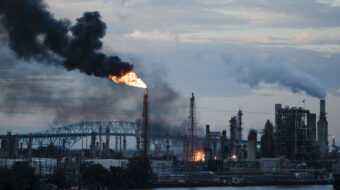
Environmentalists scored a victory after years of protest Nov. 10, when President Obama sent back to the State Department proposed gas pipeline for further review. The move will delay the project for at least a year, and could possibly stop it entirely.
The action comes after a recent demonstration in which activists surrounded the White House, the most recent in the long string of protests. In August, more than 1,200 people were arrested in one of the largest civil disobedience actions since the 1970s.
Obama acknowledged that the opposition to the pipeline had played a role in his decision. “Because this permit decision could affect the health and safety of the American people as well as the environment,” he said, “and because a number of concerns have been raised through a public process, we should take the time to ensure that all questions are properly addressed and all the potential impacts are properly understood.”
Tar Sands Action, part of the coalition of environmental, business and community groups fighting the construction of the pipeline, sent a message to supporters, saying, “We’ve come a long way in the fight against the Keystone XL pipeline. Thanks to your commitment to bold action, the president sent the pipeline back for a lengthy and thorough review that will hopefully mean the end of the project.”
103 mayors of U.S. cities sent a letter to President Obama asking him to make sure his administration takes into account the environmental impact of the pipeline on their communities in the new State Department review process.
The pipeline, known as the Keystone XL, was to bring oil extracted from Canada’s tar sands, in Alberta, to the United States. Environmentalists worried that it would put sections of both countries at risk of oil spills.
The pipeline would cut through the Ogallala aquifer, which covers a vast area underground, running from South Dakota to Texas. 30 percent of all water used for irrigation in the U.S., as well as most of the drinking water for people living above Ogallala comes from the aquifer.
As a consequence, any oil spill would devastate a large portion of the U.S. water supply.
The widespread demonstrations seem to have had some effect. According to Mark Toner, speaking for the U.S. State Department, “[W]e’re looking at … environmental issues, energy security, jobs, and economic impact, and foreign policy. So I would just say that all those issues within those subsets I think are on the table and being considered as we move forward.”
Pressed by a reporter as to whether the pipeline might be rerouted, Toner continued, “I think that’s always something that’s under consideration. We’re looking at – we’re – right now, we’re in this review phase that we’re – have not made a decision yet.” He added that not approving the project at all was “certainly” a possibility.
TransCanada, however, the company that would build the pipeline, said that the oil transit route would be built, according to the National Post.
However, environmentalists argue that even if the pipeline is moved, it would still present problems. It would generate demand for tar sand oil, which is by far dirtier than other types of oil. Its extraction produces three times as much greenhouse gases as other oil. As three gallons of water must be used to produce each barrel of oil – and the pipeline would ship 1 million gallons of water daily – 3 million gallons would be used daily.
Photo: Tar Sands Action website.

MOST POPULAR TODAY

High Court essentially bans demonstrations, freedom of assembly in Deep South

UN warns that Israel is still blocking humanitarian aid to Gaza

U.S. imperialism’s ‘ironclad’ support for Israel increases fascist danger at home


Resource wars rage in eastern Congo, but U.S. capitalism only sees investment opportunity






Comments